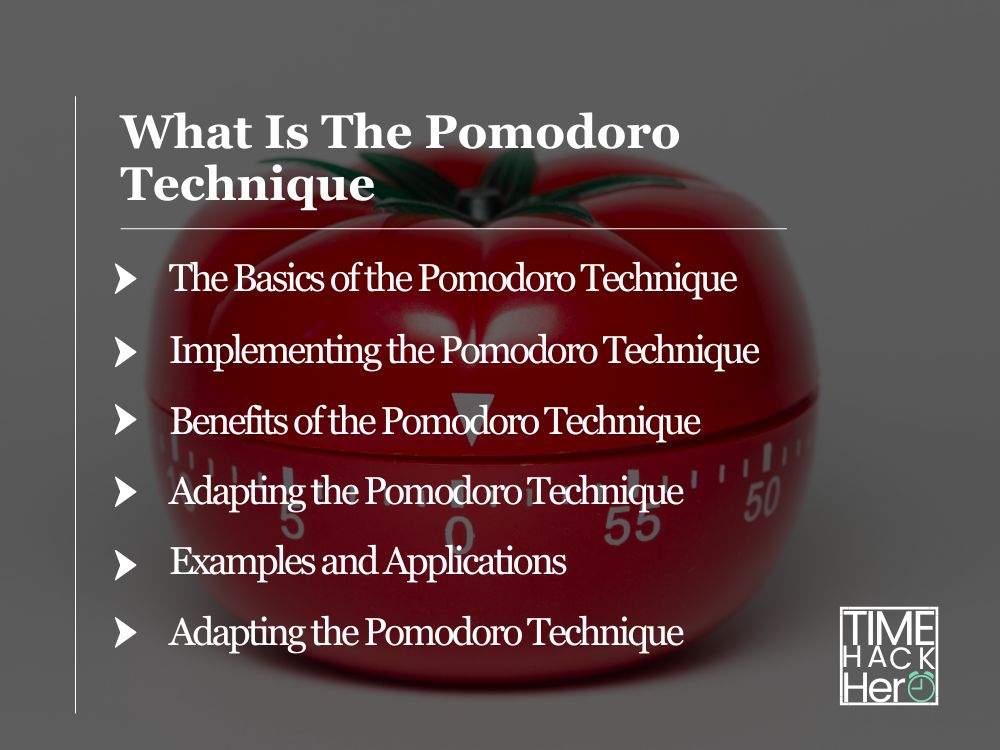The Pomodoro Technique is a time management method designed to improve focus and productivity. Developed by Francesco Cirillo in the late 1980s, the technique utilizes a kitchen timer to divide work into intervals, typically 25 minutes long, followed by short breaks. The name “pomodoro” comes from the Italian word for tomato, inspired by the tomato-shaped kitchen timer Cirillo used while piloting his strategy.
This technique aims to help users resist self-interruptions and train their brains to maintain concentration on a single task. Each 25-minute work interval, or pomodoro, is dedicated to one specific task, allowing for better time management and a sense of accomplishment upon completion. The scheduled breaks between work intervals offer opportunities to reset and refocus, enabling individuals to work more effectively for longer periods.
The simplicity and effectiveness of the Pomodoro Technique have made it a popular option for professionals, students, and creatives alike. By dividing tasks into manageable chunks of time with regular breaks, users can maintain their focus and motivation, ultimately increasing their overall productivity and success in completing their goals.
Table of Contents
The Basics of the Pomodoro Technique
Origins and Francesco Cirillo
The Pomodoro Technique is a time management method developed by Francesco Cirillo in the late 1980s. The technique is designed to help individuals improve their focus on tasks while also providing scheduled breaks for mental rest. The name “Pomodoro” comes from the Italian word for tomato, as Cirillo used a tomato-shaped kitchen timer to execute this technique during his studies.
The 25-Minute Work Interval
The core of the Pomodoro Technique is the 25-minute work interval, also known as a “pomodoro.” During these 25 minutes, the individual should focus entirely on a single task or a group of smaller tasks. The goal is to encourage productivity by dedicating undivided attention to one task and preventing multitasking or distractions.
Short Breaks and Extended Breaks
Following each 25-minute work interval, a short break of five minutes is taken. This break is designed to provide a mental reset and prevent burnout. After completing four 25-minute work intervals (or pomodoros), an extended break of 15-30 minutes is taken. This longer break allows for deeper relaxation and recovery before jumping back into tasks.
Pomodoro Timer and Tomato-Shaped Timer
The key tool in the Pomodoro Technique is the timer. While any timer can be utilized, it was initially associated with a tomato-shaped kitchen timer due to the technique’s origins. Various pomodoro timer apps and tools are available for use on computers and smartphones to facilitate the 25-minute intervals and breaks. The physical act of setting a timer can provide a sense of commitment and accountability toward the task at hand.
In conclusion, the Pomodoro Technique revolves around 25-minute work intervals focused on single tasks, short breaks after each interval, and extended breaks after four intervals. This time management technique, developed by Francesco Cirillo, is valuable in improving focus, productivity, and mental well-being.
Implementing the Pomodoro Technique
Creating a To-Do List
Begin by creating a to-do list of tasks needed to be accomplished during your workday. This helps in prioritizing tasks, visualizing your goals, and staying focused on what needs to be done.
Setting up a Workspace
Set up a dedicated workspace free from distractions to maximize productivity. Having a comfortable and organized area to work in helps in maintaining focus during the 25-minute pomodoro intervals.
Using Apps, Websites, and Tools
Numerous apps, websites, and tools can aid in implementing the Pomodoro Technique. Some tools include tomato-shaped timers, time-tracking apps, and to-do list applications. These resources offer functionalities such as tracking time spent on tasks, recording progress, and managing breaks.
| Tool | Purpose |
|---|---|
| Tomato-shaped timer | Timekeeping |
| Time-tracking apps | Monitoring progress |
| To-do list apps | Organizing tasks |
Planning and Timeboxing
Effective time management involves planning and timeboxing. Estimate the number of pomodoro intervals needed for each task and allocate them accordingly. Timeboxing helps to maintain a balance between work and breaks, ensuring optimal productivity. Adjust your plan as needed to accommodate for flexibility and changing priorities.
Paper and Pen or Digital Tracking
Choose between tracking your progress using pen and paper or using digital methods based on personal preference. Traditional pen-and-paper tracking allows for a tangible record of accomplishments while digital tracking offers ease of access and the ability to make adjustments quickly. Both methods enable monitoring progress on tasks and provide a sense of accomplishment as items are checked off the list.
Remember, the Pomodoro Technique aims to improve time-management and productivity. Utilize these steps to adapt the method to your work style and make the most of your time, whether working from home or in an office setting.
Benefits of the Pomodoro Technique
Increased Productivity
The Pomodoro Technique is designed to help you accomplish tasks and improve productivity. By breaking work into short intervals, you can maintain focus and complete tasks more efficiently. The satisfaction of ticking off completed tasks reinforces a sense of achievement, further motivating you to get more done.
Better Time Management
One of the key features of the Pomodoro Technique is time management. With 25-minute work intervals followed by 5-minute breaks, you can structure your day effectively, prioritizing tasks and allocating time accordingly. This structured approach ensures optimal use of time throughout the day.
Reduced Distractions and Interruptions
Working in short intervals helps minimize both internal and external distractions, allowing for a better flow of focused work. By dedicating 25 minutes to a task, you can train yourself to ignore interruptions, knowing that you have a designated break in the near future.
Improved Focus and Concentration
The Pomodoro Technique improves focus and concentration by encouraging you to complete tasks in shorter periods. Having a ticking timer creates a sense of urgency, pushing you to maintain focus on the task at hand. This technique not only helps you complete tasks faster but also improves overall cognitive performance.
Healthier Work Habits and Balance
Integrating short breaks after each work interval promotes healthier work habits. These breaks are an opportunity to stretch, relax and rejuvenate both physically and mentally. Taking regular breaks helps maintain a good work-life balance, reducing stress and minimizing the risk of burnout.
Overcoming Procrastination and Overlearning
Procrastination is a common challenge faced by many, and the Pomodoro Technique can help in overcoming this issue. The 25-minute work intervals are manageable, motivating you to start a task and maintain momentum throughout the day. Furthermore, the technique prevents overlearning by portioning work into focused intervals. This ensures that you are dedicating an appropriate amount of time to each task and not overloading your brain with information.
Adapting the Pomodoro Technique
Tailoring Duration and Sprints
While the traditional Pomodoro Technique recommends 25-minute sprints followed by 5-minute breaks, you can adjust the duration according to your individual needs and the nature of your tasks. Some may find shorter sprints of 15 to 20 minutes more suitable for maintaining focus, while others may prefer longer sessions up to 45 minutes to achieve a flow state. Adjusting the length of breaks is also an option, depending on the intensity of your work tasks.
Work Sessions and Pomodoro Session Variations
Different types of tasks require different levels of focus and flexibility in adapting the Pomodoro Technique. Here are some suggestions for incorporating variations in your work sessions:
- Small tasks: For tasks that can be completed quickly, consider grouping them together in a single Pomodoro session.
- Complex tasks: For tasks that require extended periods of focus, consider using longer Pomodoro sessions and extending breaks to ensure you maintain your productivity.
- Creative tasks: If you’re working on creative projects, feel free to modify the Pomodoro Technique according to your inspiration and energy levels. You can adjust the number of Pomodoro sessions or take extended breaks when necessary.
Increasing Efficiency and Scope
Implementing the Pomodoro Technique can improve efficiency and broaden the scope of work that can be accomplished in a given timeframe. Some suggestions for making the most of your Pomodoro sessions include:
- Task prioritization: Arrange your tasks according to priority, and complete the most important tasks during your peak productivity hours.
- Estimating time: Estimate the number of Pomodoro sessions needed for each task to help you allocate your time more effectively.
- Evaluating progress: Use your completed Pomodoro sessions as a measure of your progress. Adjust the duration or frequency of your sessions as needed to maintain steady progress.
By tailoring the Pomodoro Technique to your personal style and the nature of your work tasks, you can better manage your time and improve overall productivity.
Examples and Applications
Using Pomodoro for Studying
The Pomodoro Technique is ideal for managing study sessions. Students can:
- Set a timer for 25 minutes and focus solely on the material they’re studying
- Take a 5-minute break after the timer goes off to rest and recharge
- Repeat this process for four Pomodoros, followed by an extended break (15-30 minutes) to prevent burnout
This structured approach helps improve focus and concentration, and supports effective time management for studying.
Coding and Complex Projects
The Pomodoro method is also beneficial for professionals working on complex tasks, such as coding and project management. They can:
- Break tasks into smaller, manageable chunks (Pomodoros)
- Set a timer for 25 minutes, focusing only on the task at hand
- Use breaks to refresh their minds or review the progress
The technique helps reduce overall stress and prevents feelings of being overwhelmed by large projects.
Writing, Design, and Other Creative Pursuits
Creative professionals, such as writers and designers, can also benefit from the Pomodoro Technique by:
- Dividing their work into 25-minute focused sessions
- Taking breaks to clear their minds, engage in short walks or brain training activities
- Using the structure to manage distractions and maintain motivation
The Pomodoro method enhances creativity and productivity by preventing burnout and promoting a well-balanced workflow.
Incorporating Breaks and Short Walks
Integrating breaks and short walks into the Pomodoro Technique is essential for:
- Boosting mental and physical well-being
- Improving focus and concentration
- Reducing stress and preventing burnout
During the 5-minute breaks, individuals can stretch, take a short walk, or engage in light mental activities. The extended breaks (15-30 minutes) after every four Pomodoros can be used for more thorough rest or longer walks to rejuvenate and maintain productivity.









